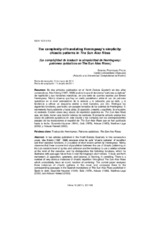Mostrar el registro sencillo del ítem
The complexity of translating Hemingway’s simplicity: chiastic patterns in The Sun Also Rises
| dc.contributor.author | Rodríguez Pazos, Gabriel | es_ES |
| dc.date.accessioned | 2020-01-22T11:22:00Z | |
| dc.date.available | 2020-01-22T11:22:00Z | |
| dc.date.issued | 2011 | |
| dc.identifier.issn | 1579-9794 | |
| dc.identifier.uri | http://hdl.handle.net/10396/19349 | |
| dc.description.abstract | En dos artículos publicados en el North Dakota Quarterly en dos años consecutivos, Max Nänny (1997, 1998) analiza lo que él denomina “patrones quiásticos” de repetición y sus funciones narrativas, en una serie de cuentos escritos por Ernest Hemingway. Nänny observa que hay un cierto paralelismo entre el uso de patrones quiásticos en el nivel subnarrativo de la sintaxis y la cohesión, por un lado, y la tendencia a utilizar un esquema similar a nivel narrativo, por otro. Distingue las siguientes funciones, que ilustra con pasajes tomados de los cuentos de Hemingway: 1) movimiento hacia adelante y hacia atrás, 2) oposición, simetría y equilibrio, 3) encuadre, 4) centrado. Existen casos muy obvios de repetición quiástica en The Sun Also Rises que, sin duda, tienen una función icónica de centrado. El presente artículo analiza tres casos de patrones quiásticos en esta novela y los compara con los correspondientes pasajes de las traducciones al español de The Sun Also Rises que se han publicado hasta la fecha: Guarnido-Hausner (1944), Solá (1979), Adsuar (1983), Martínez-Lage (2002), y Adsuar-Hamad (2003 | es_ES |
| dc.description.abstract | In two articles published in the North Dakota Quarterly in two consecutive years, Max Nänny (1997, 1998) analyses what he calls “chiastic patterns” of repetition and their narrative functions, in a number of short stories written by Hemingway. Nänny observes that there is some kind of parallelism between the use of chiastic patterning on the sub-narrative level of syntax and cohesion and the tendency to use a similar scheme at the level of the narrative, and he distinguishes the following functions, which he illustrates with passages taken from Ernest Hemingway‟s short stories: 1) back and forth movement, 2) opposition, symmetry, and balance, 3) framing, 4) centering. There is a number of very obvious instances of chiastic repetition throughout The Sun Also Rises which undoubtedly have an iconic function of centering. The current paper analyses three instances of chiastic patterns in this novel and compares them to the corresponding passages in the Spanish translations of The Sun Also Rises published in Spain to date: Guarnido-Hausner (1944), Solá (1979), Adsuar (1983), Martínez-Lage (2002), and Adsuar-Hamad (2003). | es_ES |
| dc.format.mimetype | application/pdf | es_ES |
| dc.language.iso | eng | es_ES |
| dc.publisher | UCOPress | es_ES |
| dc.rights | https://creativecommons.org/licenses/by-nc-nd/4.0/ | es_ES |
| dc.source | Hikma 10, 123-138 (2011) | es_ES |
| dc.subject | Hemingway, Ernest, 1899-1961 | es_ES |
| dc.subject | Traducción | es_ES |
| dc.subject | Patrones quiásticos | es_ES |
| dc.subject | Sun Also Rises, The | es_ES |
| dc.subject | Chiastic patterns | es_ES |
| dc.subject | Translation | es_ES |
| dc.title | The complexity of translating Hemingway’s simplicity: chiastic patterns in The Sun Also Rises | es_ES |
| dc.title.alternative | La complejidad de traducir la simplicidad de Hemingway: patrones quiásticos en The Sun Also Rises | es_ES |
| dc.type | info:eu-repo/semantics/article | es_ES |
| dc.relation.publisherversion | https://www.uco.es/ucopress/ojs/index.php/hikma/index | es_ES |
| dc.rights.accessRights | info:eu-repo/semantics/openAccess | es_ES |

